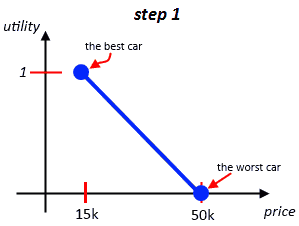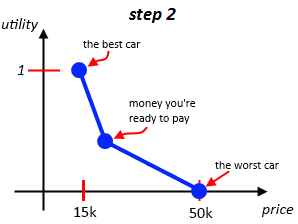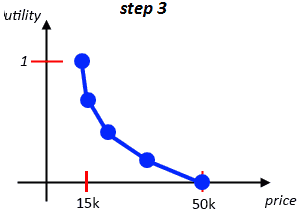Multi-Attribute Utility Theory
Multi-Attribute Utility Theory or MAUT is a method of Multi-Criteria Decision Aid
Utility Functions
Suppose we have a global utility function $U(a)$ that aggregates all criteria into one value:
- $U(a) = U(g_1(a), …, g_k(a))$
Additive Utility Functions
$U(a) = \sum_{j=1}^k u_j(g_j(a))$
- behind this we can have the Weighted Sum Model
| The evaluation table: |
||||||||||||||||||||||
| Price | Comfort | $a$ | 300 | Medium | $b$ | 350 | Good | $c$ | 400 | Good | $d$ | 450 | Very Good | |||||||||
| The utility functions: |
||||||||||||||||||||||
| $u_1$ | $u_2$ | 8.5 | 4 | 8 | 7 | 6 | 7 | 5 | 10 |
With weights $k_1 = 7$ and $k_2 = 3$ we establish the ranking based on the following values:
- $u(a) = 7 \cdot 8.5 + 3 \cdot 4 = 71.5$
- $u(b) = 7 \cdot 8 + 3 \cdot 7 = 77$
- $u(c) = 7 \cdot 6 + 3 \cdot 7 = 63$
- $u(d) = 7 \cdot 5 + 3 \cdot 10 = 65$
- $b > a > d > c$
Marginal Utilities
At first we transform the evaluation into two “marginal utilities”:
- we transform evaluation of all criteria into a scale $[0, 1]$
So with the weighted sum we have
- $U(a) = \sum{k=1}{n} w_k u_k(a)$
- we want $u_k \in [0, 1]$
Suppose you want to buy a car
- the prices range from 15k to 50k
- so first step is assigning 1 to 15k and 0 to 50k
- we’ve got a linear utility function
- but this is only just the first approximation of our preferences

- we know that we’re willing to spend somewhere around 20k
- we want $u(20k) = 0.5$
- so we modify the function by adding an additional point - now there’re two linear function
- this is the second approximation of our preferences

- can repeat this for both left and right sides to get the 3rd approximation
- and define $u(p_1) = 0.75$ and $u(p_2) = 0.25$

- and so on
Examples
Consider an additive model and the following evaluation table
| $g_1$ | $g_2$ | $a_1$ | 1 | 1 | $a_2$ | 1 | 3 | $a_3$ | 1 | 5 | $a_4$ | 2 | 1 | $a_5$ | 2 | 3 | $a_6$ | 2 | 5 | $a_7$ | 3 | 1 | $a_8$ | 3 | 3 | $a_9$ | 3 | 5 |
Based on this table a Decision Maker gives his preferences:
- $a_9 \ P \ a_6 \ P \ a_8 \ P \ a_5 \ P \ a_3 \ I \ a_7 \ P \ a_2 \ I \ a_4 \ P \ a_1$
This ordering satisfied the Preferential Independence criteria.
Definition: $\exists a,b,c,d \in A$, and set of criteria $J \cup \overline{J} = G$
- $g_i(a) = g_i(b), \forall i \not \in J$
- $g_i(c) = g_i(d), \forall i \not \in J$
- $g_i(a) = g_i(a), \forall i \in J$
- $g_i(b) = g_i(d), \forall i \in J$
In this case $J = {g_1}, \overline{J} = {g_2}$
- under $J$: $a_1 = a_2 = a_3; a_4 = a_5 = a_6; a_7 = a_8 = a_8$
- under $\overline{J}$: $a_1 = a_4 = a_7; a_2 = a_5 = a_8; a_3 = a_7 = a_9$
Need to check if this principle is satisfied for all possible combinations
For example, $a_1, a_4, a_5, a_5$:
- $a_4 \ P \ a_1 \iff a_5 \ P \ a_2$
- this indeed holds
Now we want to check how the decision maker obtained this ranking
- can we model it with an utility function?
- note that $a_3 \ I \ a_7$
- then under the utility model it should be true that $U(a_3) = U(a_7)$
- $u_1(g_1(a_3)) + u_2(g_2(a_3)) = u_1(g_1(a_7)) + u_2(g_2(a_7)) = …$
- $… = u_1(1) + u_2(5) = u_1(3) + u_2(1) \ \ \ (*)$
- also $a_2 \ I \ a_4$
- then $U(a_2) = U(a_4)$
- or $u_1(1) + u_2(3) = u_1(2) + u_2(1) \ \ \ (**)$
- let’s try to find the utility function
- check $(*) - (**)$
- $u_2(5) - u_2(3) = u_1(3) - u_1(2) \Rightarrow u_1(2) + u_2(5) = u_1(3) + u_2(3)$
- we see that $a_6$ is evaluated to $(2, 5)$ and $a_8$ is evaluated to $(3, 3)$
- but it means that we should also have $a_6 \ I \ a_8$ - which is not the case
- thus it’s not possible to establish